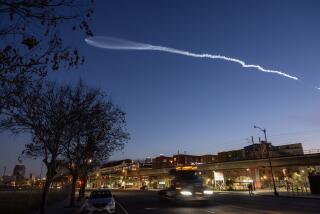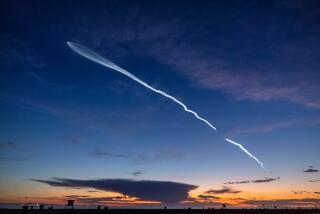2 Federal Panel Members Tour Point Mugu : Base closures: Commissioners say they are undecided about whether to relocate its naval facilities to China Lake.
Two members of a federal base-closing commission Tuesday toured the labs that test missiles fired by fighter jets featured in the movie “Top Gun,” examined assorted flying objects the Navy tries to blow from the sky and ventured into a darkened room full of radar screens that looks like a miniature Mission Control.
Commissioners Benjamin F. Montoya and Rebecca Cox visited Point Mugu to find out if they can save tax dollars by moving its extensive missile-testing operations to another Navy base.
“I want to assure you that if we find otherwise, this is one commissioner who will gladly vote to leave it [Point Mugu] alone,” Montoya said at a news conference before the tour.
Montoya and Cox assured reporters and a roomful of naval officers that they had made no decisions on the proposal to mothball most of the base and move its testing labs 160 miles to the China Lake naval base in the upper Mojave Desert.
They promised to pass along what they learned on their tour back to the six other members of the base-closing commission who will decide the fate of Point Mugu and 180 other bases being weighed for closure or realignment.
The commission must complete its work and submit its closure list to President Clinton by July 1.
Montoya, a retired admiral who spent the early 1960s as a Seabee stationed at the nearby Port Hueneme Navy base, was the commissioner who nominated Point Mugu for addition to the Pentagon’s list of recommended closures.
But Montoya said he felt a fondness for Ventura County, where he was stationed from 1962 to 1967.
“It’s nice to be in an area I used to think of as home,” Montoya said. “I spent five years here as a young naval officer. I think we had our fourth child here in town. I had a lot of fun on the beaches of Point Mugu.”
Montoya and Cox are seen by Point Mugu backers as the pivotal commissioners in the upcoming decision on Point Mugu. Other members of the Defense Base Closure and Realignment Commission are likely to seek their advice, given Montoya’s extensive Navy background and that he and Cox were the only commissioners to actually tour the base.
Point Mugu supporters also view them as potentially the most friendly.
Cox, a United Airlines executive and former Reagan Administration official, is the wife of Rep. Christopher Cox (R-Newport Beach). She is well-known to members of the California congressional delegation and sensitive to their concerns about losing more military jobs in a state that has suffered 22 base closures in recent years.
Furthermore, Congressman Cox has been a political ally to Rep. Elton Gallegly (R-Simi Valley), who is aggressively lobbying on behalf of Point Mugu. With about 9,000 jobs, the base is the biggest employer in Ventura County.
At Tuesday’s news conference, Cox said her only direct experience with Point Mugu was arriving on a plane with then-President Reagan, who used to land Air Force One there when coming home to California.
She declined to speculate on the odds of Point Mugu’s closure. “It’s really too early to say at this point,” she said. “We are just going through the fact-finding part.”
Gallegly and Rep. Anthony C. Beilenson (D-Woodland Hills), who represents the Conejo Valley, accompanied the commissioners on their tour.
So did nearly all of the top officers from Point Mugu and two visiting admirals who have wide influence over Navy policy.
Adm. Ronald J. Zlatoper, commander in chief of the Pacific Fleet, and Adm. John A. Lockard, head of all naval aviation, said they each took red-eye flights Monday night to get to Point Mugu because they wanted to show their commitment to the base.
“This is a vital complex,” Zlatoper said.
Lockard said Point Mugu and its missile-testing range over the Pacific Ocean are critical to the Navy’s needs to test-fire weapons.
“Clearly, this area offers an opportunity that doesn’t exist anywhere else,” he said. “To duplicate this would be very expensive.”
Among other places the 28-person entourage visited the lab that tests missiles for the F-14 Tomcat, a staging area filled with unmanned aircraft the Navy uses as missile targets and the control center for Point Mugu’s missile testing range that stretches across 36,000 square miles of the ocean.
In addition to touring Point Mugu in four vans, the group flew to China Lake to visit the other principal base that makes up the Naval Air Warfare Center, Weapons Division.
At the morning briefing, Montoya said he had not studied the details of the Pentagon audit that helped inspire staff to consider closing Point Mugu. But he said he was familiar with its promise of $1.7 billion in savings over 20 years.
“If someone thinks they can save almost $2 billion . . . you need to examine that,” he said.
He said he had just learned of the Navy’s calculations, which figure the consolidation would cost taxpayers $436 million during the same 20-year period. “That’s a lot of money,” he said. “I have just enough background to ask a few questions about those numbers.”
Moreover, he said the commissioners feel compassion for the impact of their decision on the lives of local residents.
“We understand the difficulties that communities would face in the closing of a base,” Montoya said. “And we understand the trauma that families would be subjected to if a base were to be closed.
“But the reality of life is that our armed forces have gone down in large numbers over the past few years,” he said. “It is incumbent upon us to recognize that and shrink the shore establishment to be somewhat commensurate with the operating forces.”
More to Read
Sign up for Essential California
The most important California stories and recommendations in your inbox every morning.
You may occasionally receive promotional content from the Los Angeles Times.










